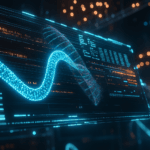The ocean’s size and mystique have always captured people’s interest. Scientists and researchers have created advanced tools for underwater exploration in order to investigate and comprehend the marine environment. Autonomous Underwater Vehicles (AUVs) have become an innovative option, providing unmatched prospects for marine exploration and study.
Self-propelled, unmanned AUVs may travel through the ocean’s depths, gather data, and carry out a variety of other duties without direct human involvement. They are used for a variety of things, including underwater mapping, environmental monitoring, marine animal observation, and even underwater structural inspections.
The usage of Field-Programmable Gate Arrays (FPGAs) is one of the fundamental enabling technologies that has substantially improved the capabilities of AUVs.
FPGAs are adaptable semiconductor devices that may be customized and programmed to effectively carry out particular jobs. In the tough and resource-constrained underwater environment, they offer enormous benefits in terms of flexibility, real-time computing, and low power consumption.
We shall examine how FPGA technology is advancing marine exploration using AUVs in this post. We will examine the difficulties encountered in aquatic environments and how FPGAs resolve these difficulties, enhancing the adaptability and capability of AUVs for a variety of applications.
Challenges in AUVs and the Role of FPGA
Due to their capacity to independently navigate the depths of the ocean and complete a variety of tasks, autonomous underwater vehicles (AUVs) have emerged as crucial tools in marine exploration and research. To ensure the successful operation of AUVs, various issues related to the underwater environment must be resolved. These difficulties include:
Harsh and Unpredictable Conditions: The harsh undersea environment includes high pressure, abrupt temperature changes, and corrosive seawater. To endure these circumstances and maintain the integrity of its systems, AUVs need to be built to last.
Limited Communication: AUVs frequently operate in isolated locations, disconnected from human operators. They must therefore possess the capacity for autonomous decision-making as well as the capacity for situational adaptation.
Power Constraints: Energy efficiency is essential for extending the operational duration of AUVs, which are normally powered by batteries. For missions to last as long as possible and travel farthest, effective power management systems are crucial.
Real-Time Data Processing: AUVs gather enormous volumes of data using their onboard sonar, camera, and environmental sensors. To gather pertinent data and make quick judgments, real-time data processing is essential.
Precision Navigation and Control: AUVs must accurately navigate in three-dimensional underwater settings while avoiding hazards and keeping stable control. To guarantee a mission is completed successfully, precise navigation and control systems are required.
Data Fusion and Integration: AUVs may carry multiple sensors, each providing valuable data. Effective data fusion and integration techniques are required to combine information from different sensors and improve the accuracy of the overall data.
Field-Programmable Gate Arrays (FPGAs) play a pivotal role in addressing these challenges and enhancing the capabilities of AUVs.
Here’s how FPGAs contribute to overcoming the obstacles faced in underwater exploration:
Real-Time Data Processing: FPGAs are renowned for their capacity for parallel processing, which enables them to manage massive amounts of data in real-time. AUVs can swiftly assess sensor data and make decisions by outsourcing data processing chores from the main CPU to FPGAs, enabling adaptive behavior in dynamic underwater situations.
Customizable Hardware Design: FPGA devices offer flexibility in hardware design and functionality since they can be reprogrammed on the fly. With the use of this functionality, AUV designers can customize the FPGA implementation to meet their vehicle’s unique mission needs and maximize resource efficiency.
Low Power Consumption: FPGAs are more energy-efficient than conventional CPUs and GPUs, which makes them ideal for energy-restricted AUV applications. Critical algorithms can be implemented on FPGAs, allowing AUVs to save power and run longer missions.
Sensor Data Fusion: FPGA-based data fusion enables real-time integration and processing of data from multiple sensors, allowing AUVs to generate more comprehensive and accurate representations of the underwater environment. This, in turn, enhances their perception and decision-making capabilities.
Real-Time Control Systems: FPGAs can be employed in the design of control systems, ensuring precise navigation and stabilization of AUVs. Their ability to handle high-frequency control loops enables responsive and agile movements in challenging underwater conditions.
Rapid Prototyping and Iteration: FPGAs facilitate rapid prototyping and iterative development in AUV design. Designers can quickly test and modify FPGA configurations, accelerating the development process and improving the overall performance of AUV systems.
FPGA Technology in AUVs
FPGAs (Field-Programmable Gate Arrays) have emerged as a crucial technology in the domain of Autonomous Underwater Vehicles (AUVs). These reprogrammable integrated circuits offer a unique set of advantages that make them well-suited for addressing the challenges posed by the underwater environment. Let’s explore how FPGA technology enhances the capabilities of AUVs and enables them to excel in marine exploration.
Real-Time Processing and Low Latency: Real-time data processing with reduced latency is one of the most important advantages of using FPGAs in AUVs. Rapid decision-making is essential for navigating through barriers, adjusting to shifting conditions, and reacting to potential hazards in the underwater environment. FPGAs excel at parallel processing, enabling the execution of numerous operations concurrently, reducing processing times, and enhancing responsiveness.
Flexibility and Adaptability: AUV systems must be adaptable due to the ocean’s unpredictable and ever-changing nature. FPGAs have the benefit of being reprogrammable, allowing AUV designers to alter and improve their algorithms in accordance with mission needs. When dealing with a variety of underwater environments and scientific goals, this adaptability is important.
Power Efficiency: Since AUVs normally run on batteries, power consumption is a major issue for missions that last a long time. FPGAs are renowned for using less power than conventional processors like CPUs and GPUs. FPGAs assist in extending the working period of AUVs by effectively utilizing available power, allowing for longer missions and more thorough data collecting.
Hardware Acceleration: Complex algorithms for autonomous navigation as well as image processing and sensor data fusion are frequently used in underwater exploration. Through hardware-level improvements, certain tasks can be sped up on FPGAs. The performance of AUVs is greatly improved while the main processor unit is put under less stress thanks to this hardware acceleration.
Data Integrity and Security: AUVs produce enormous volumes of data using a variety of sensors and imaging equipment. Particularly in critical research and defense applications, ensuring data confidentiality and integrity is essential. Strong encryption and data validation procedures can be implemented using specialized FPGAs to protect sensitive data from threats or unauthorized access.
Redundancy and Fault Tolerance: For AUVs operating in distant and difficult areas, dependability is crucial. The implementation of redundant and fault-tolerant systems using FPGAs enables the AUV to carry out its mission even in the face of hardware failures or unforeseen circumstances.
Size, Weight, and Power (SWaP) Considerations: AUVs are often constrained by limited space and payload capacity. FPGAs offer a compact and lightweight processing solution, contributing to the overall SWaP optimization of the vehicle.
Prototyping and Rapid Development: FPGA-based development platforms provide AUV researchers with the means to rapidly prototype and test new algorithms and functionalities. This accelerated development cycle enhances innovation and reduces time-to-market for new AUV systems and features.
Applications of FPGA in AUVs
Field-Programmable Gate Arrays (FPGAs) have proven to be invaluable in enhancing the capabilities of Autonomous Underwater Vehicles (AUVs). Their unique characteristics and ability to be programmed for specific tasks make them ideal for addressing the challenges encountered in underwater environments. Let’s explore some of the key applications of FPGA technology in AUVs:
Navigation and Control Systems:
AUVs need precise navigation and control to successfully carry out their tasks. With elements like currents, barriers, and different depths, underwater settings can be unexpected. FPGAs are essential for processing sensor data in real-time and running sophisticated algorithms for autonomous navigation and obstacle avoidance.
They make it possible for AUVs to quickly change their path and make judgments as needed, ensuring safe and effective navigation through submerged terrain.
Image and Signal Processing for Underwater Imaging:
For a variety of marine exploration tasks, such as mapping underwater terrains, checking underwater structures, and investigating marine life, underwater imaging is essential. Low visibility, turbulence, and light dispersion present difficulties for image processing in the underwater environment.
Real-time picture enhancing and compression are ideal applications for FPGAs because of their superior hardware acceleration and parallel processing capabilities. AUVs can acquire, process, and transmit high-quality photos even in difficult underwater settings by using FPGA-based image and signal processing.
Sensor Data Fusion and Real-time Processing:
To obtain important information about the underwater environment, AUVs are furnished with a variety of sensors, including sonars, cameras, and environmental sensors. The process of combining data from various sensors to produce a thorough picture of the environment is known as sensor data fusion.
AUVs can aggregate and evaluate data from numerous sensors in real time because to FPGA-based sensor data fusion. The AUV can make informed decisions and adjust its operations to changing environmental circumstances thanks to this integrated data.
Machine Learning and Artificial Intelligence for AUVs:
Marine exploration is one of many sectors being transformed by machine learning (ML) and artificial intelligence (AI). AUVs can use ML algorithms to identify underwater objects, spot patterns in sensor data, and even make wise decisions based on prior experiences.
AUVs equipped with FPGAs can learn and adapt to new circumstances and settings more quickly because of their ability to analyze data in parallel.
Data Compression and Communication:
AUVs frequently operate in isolated areas with constrained communication bandwidth. Large amounts of raw sensor data may be difficult and time-consuming to transmit to the surface.
Real-time data compression performed by FPGAs can effectively cut down on the quantity of data that needs to be communicated while preserving critical information.
In addition to improving communication, data compression enables AUVs to store more data aboard for prolonged missions.
FPGA Implementation in AUVs
Field-Programmable Gate Arrays (FPGAs) play a pivotal role in advancing the capabilities of Autonomous Underwater Vehicles (AUVs). Their unique characteristics, such as parallel processing, low latency, and reconfigurability, make them an ideal choice for addressing the challenges posed by the underwater environment. In this section, we will explore how FPGAs are implemented in AUVs and the specific areas where their integration brings significant advantages.
A. Hardware Design Considerations and Constraints
Designing AUVs for underwater research necessitates careful consideration of hardware constraints. FPGAs have advantages in terms of power consumption, physical footprint, and weight because they are highly adaptable hardware.
These elements are essential for AUVs because they have limited energy and space resources. Engineers can maximize the total system performance while ensuring that it remains small and energy-efficient by customizing the FPGA design to suit the unique application needs.
FPGAs also make it possible to combine several functionalities onto a single chip, eliminating the need for additional hardware parts. This unification of functions streamlines the hardware design of the AUV, improving dependability and lowering possible failure points—a significant factor in difficult and remote underwater missions.
B. Real-time Data Processing
The capacity of FPGA implementation in AUVs to process data in real-time is one of their key benefits. Making wise decisions in underwater exploration requires timely and reliable data analysis. FPGAs are excellent in processing massive volumes of data with low latency, whether it is high-resolution sonar data, real-time image processing for object detection, or environmental monitoring data.
For instance, FPGAs can manage sensor data fusion from many sources, such as sonar, cameras, and inertial measurement units (IMUs), in navigation and control systems to offer exact and current knowledge about the position, orientation, and surroundings of the AUV. AUVs are able to conduct complex maneuvers with astounding precision and quickly adjust to shifting environmental conditions thanks to their real-time data processing capabilities.
C. Signal and Image Processing
For many purposes, such as studying marine life, doing archaeological research, and inspecting infrastructure, underwater imaging is essential. However, due to poor vision, dim lighting, and water-induced image distortion, underwater imaging presents particular difficulties. FPGAs are very effective at real-time image correction and enhancement because they are excellent at parallel processing.
AUVs can process images instantly, enhancing their quality and clarity in real time, by directly integrating complex algorithms into the FPGA. When data transfer to the surface for processing is impractical because of bandwidth and connectivity limitations, this function is especially helpful.
D. Sensor Data Fusion and Redundancy
AUVs have a variety of sensors to collect information about the marine environment. These sensors frequently produce large amounts of data, and it is essential to effectively glean valuable insights from this information. FPGAs provide sensor data fusion, which combines, cross-references, and analyzes data from numerous sensors to provide a thorough picture of the undersea environment.
FPGAs can also help with redundancy management, which uses numerous sensors of the same kind to guarantee system robustness. The FPGA can seamlessly transition to alternative sensors in the event of sensor failure, allowing the AUV to carry out its mission with little interruption.
E. Machine Learning and Artificial Intelligence
Path planning, object recognition, and anomaly detection are just a few of the AUV tasks that have been demonstrated to benefit greatly from machine learning and artificial intelligence. Onboard the AUV, FPGAs provide the computational capacity necessary to execute machine learning algorithms, allowing for real-time decision-making based on the data gathered throughout the voyage.
AUVs can effectively process the data, adapt their behavior based on recognized patterns, and even dynamically change their mission objectives by utilizing FPGA’s parallel processing capabilities.
Challenges and Limitations of FPGA in AUVs
While FPGA technology has revolutionized AUVs and propelled them to new heights in marine exploration, it is essential to acknowledge that it also faces several challenges and limitations. As with any advanced technology, understanding these limitations is crucial for optimizing their application and ensuring efficient use in AUV systems. In this section, we explore the primary challenges and limitations of FPGA technology in the context of Autonomous Underwater Vehicles.
Power and Resource Constraints:
Power availability is one of the major problems that AUVs, particularly those using FPGAs, must deal with. AUVs are made for long-duration missions, so it is crucial to carefully control power consumption to increase their operating endurance.
Despite being far more efficient than general-purpose processors, FPGAs still need energy. The power budget may be strained by the implementation of sophisticated algorithms and resource-intensive operations on FPGAs, hence reducing the overall mission time and performance. To achieve efficient AUV operation, engineers must strike a precise balance between FPGA usage and power conservation.
Programming Complexity and Maintenance:
FPGA programming is more difficult than conventional software development since it calls for specific knowledge and experience. A thorough understanding of hardware description languages (HDLs) like Verilog or VHDL is necessary for designing and configuring FPGA circuits.
Furthermore, depending on the goals of the mission or modifications to sensor configurations, FPGA designs can need periodic upgrades or modifications. As it is not always possible to update the FPGA during the voyage, this creates a maintenance difficulty. For the deployment of trustworthy FPGA designs in AUVs, careful planning and thorough testing are required.
Scalability and Adaptability Issues:
AUVs must adjust to new missions, sensor technology, and data processing requirements as the needs for marine exploration change. It’s possible that FPGA designs aren’t always easily scalable or adaptive to these modifications.
FPGAs frequently need physical reconfiguration or replacement, unlike software-based systems, which can be updated remotely. This constraint may make it difficult for AUVs to deploy improved functions quickly and may force hardware redesign for certain missions.
Limited Processing Speed:
The processing speed of specialized application-specific integrated circuits (ASICs) or expensive graphics processing units (GPUs) may nevertheless be faster than that of FPGAs, despite their excellent parallel processing capabilities. The efficiency of a mission could be impacted if some sophisticated algorithms or real-time applications exceed the capabilities of an FPGA.
To strike the perfect balance between an FPGA’s flexibility and processing speed, engineers must carefully examine the processing needs of AUV jobs and choose the appropriate hardware platform.
Cost Considerations:
FPGAs, being specialized hardware components, can be relatively expensive compared to general-purpose processors. This higher cost could influence the decision to adopt FPGA technology in AUVs, especially in cost-sensitive missions or when large-scale AUV deployments are required. Balancing performance and cost-effectiveness becomes a critical factor in FPGA integration.
Conclusion:
In conclusion, the development of autonomous underwater vehicles (AUVs) using FPGA technology has transformed marine exploration. FPGA-equipped AUVs are capable of autonomously completing difficult tasks, processing data in real time, and navigating through difficult underwater situations. Despite difficulties like limited power and extensive programming, FPGA-powered AUVs have produced ground-breaking findings and improved our comprehension of the ocean’s mysteries. We may anticipate even more advanced AUV systems as FPGA technology research and development progresses, pushing marine exploration to new heights and inspiring future generations to discover and preserve our planet’s undersea environment.


![What is FPGA Introduction to FPGA Basics [2023] computer-chip-dark-background-with-word-intel-it](https://fpgainsights.com/wp-content/uploads/2023/06/computer-chip-dark-background-with-word-intel-it-300x171.jpg)









